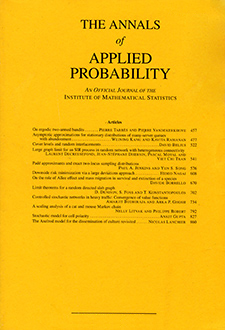Abstract
We study the SIR epidemic model with infections carried by $k$ particles making independent random walks on a random regular graph. Here we assume $k\leq n^{\epsilon}$, where $n$ is the number of vertices in the random graph, and $\epsilon$ is some sufficiently small constant. We give an edge-weighted graph reduction of the dynamics of the process that allows us to apply standard results of Erdős–Rényi random graphs on the particle set. In particular, we show how the parameters of the model give two thresholds: In the subcritical regime, $O(\ln k)$ particles are infected. In the supercritical regime, for a constant $\beta\in(0,1)$ determined by the parameters of the model, $\beta k$ get infected with probability $\beta$, and $O(\ln k)$ get infected with probability $(1-\beta)$. Finally, there is a regime in which all $k$ particles are infected. Furthermore, the edge weights give information about when a particle becomes infected. We exploit this to give a completion time of the process for the SI case.
Citation
Mohammed Abdullah. Colin Cooper. Moez Draief. "Viral processes by random walks on random regular graphs." Ann. Appl. Probab. 25 (2) 477 - 522, April 2015. https://doi.org/10.1214/13-AAP1000
Information





